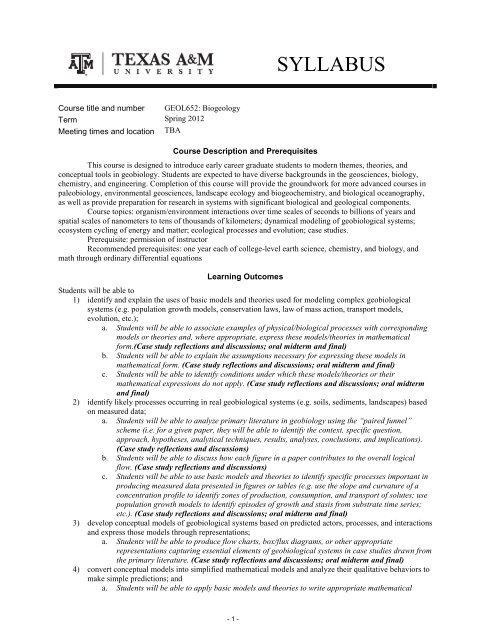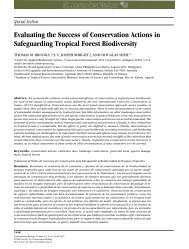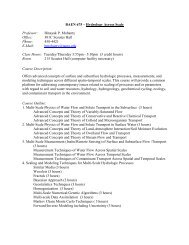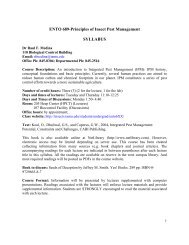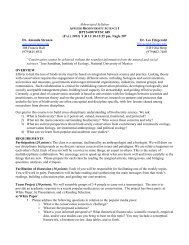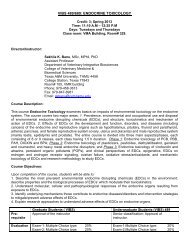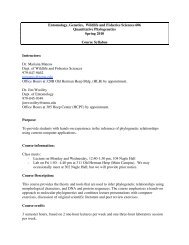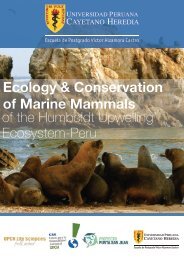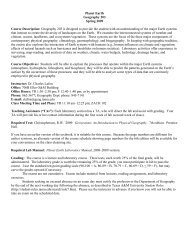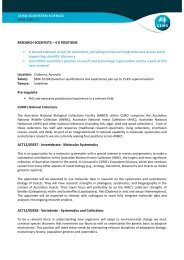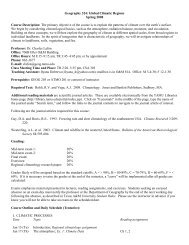SYLLABUS - Ecology and Evolutionary Biology
SYLLABUS - Ecology and Evolutionary Biology
SYLLABUS - Ecology and Evolutionary Biology
You also want an ePaper? Increase the reach of your titles
YUMPU automatically turns print PDFs into web optimized ePapers that Google loves.
Course title <strong>and</strong> number GEOL652: Biogeology<br />
Term<br />
Spring 2012<br />
Meeting times <strong>and</strong> location TBA<br />
Course Description <strong>and</strong> Prerequisites<br />
- 1 -<br />
<strong>SYLLABUS</strong><br />
This course is designed to introduce early career graduate students to modern themes, theories, <strong>and</strong><br />
conceptual tools in geobiology. Students are expected to have diverse backgrounds in the geosciences, biology,<br />
chemistry, <strong>and</strong> engineering. Completion of this course will provide the groundwork for more advanced courses in<br />
paleobiology, environmental geosciences, l<strong>and</strong>scape ecology <strong>and</strong> biogeochemistry, <strong>and</strong> biological oceanography,<br />
as well as provide preparation for research in systems with significant biological <strong>and</strong> geological components.<br />
Course topics: organism/environment interactions over time scales of seconds to billions of years <strong>and</strong><br />
spatial scales of nanometers to tens of thous<strong>and</strong>s of kilometers; dynamical modeling of geobiological systems;<br />
ecosystem cycling of energy <strong>and</strong> matter; ecological processes <strong>and</strong> evolution; case studies.<br />
Prerequisite: permission of instructor<br />
Recommended prerequisites: one year each of college-level earth science, chemistry, <strong>and</strong> biology, <strong>and</strong><br />
math through ordinary differential equations<br />
Learning Outcomes<br />
Students will be able to<br />
1) identify <strong>and</strong> explain the uses of basic models <strong>and</strong> theories used for modeling complex geobiological<br />
systems (e.g. population growth models, conservation laws, law of mass action, transport models,<br />
evolution, etc.);<br />
a. Students will be able to associate examples of physical/biological processes with corresponding<br />
models or theories <strong>and</strong>, where appropriate, express these models/theories in mathematical<br />
form.(Case study reflections <strong>and</strong> discussions; oral midterm <strong>and</strong> final)<br />
b. Students will be able to explain the assumptions necessary for expressing these models in<br />
mathematical form. (Case study reflections <strong>and</strong> discussions; oral midterm <strong>and</strong> final)<br />
c. Students will be able to identify conditions under which these models/theories or their<br />
mathematical expressions do not apply. (Case study reflections <strong>and</strong> discussions; oral midterm<br />
<strong>and</strong> final)<br />
2) identify likely processes occurring in real geobiological systems (e.g. soils, sediments, l<strong>and</strong>scapes) based<br />
on measured data;<br />
a. Students will be able to analyze primary literature in geobiology using the “paired funnel”<br />
scheme (i.e. for a given paper, they will be able to identify the context, specific question,<br />
approach, hypotheses, analytical techniques, results, analyses, conclusions, <strong>and</strong> implications).<br />
(Case study reflections <strong>and</strong> discussions)<br />
b. Students will be able to discuss how each figure in a paper contributes to the overall logical<br />
flow. (Case study reflections <strong>and</strong> discussions)<br />
c. Students will be able to use basic models <strong>and</strong> theories to identify specific processes important in<br />
producing measured data presented in figures or tables (e.g. use the slope <strong>and</strong> curvature of a<br />
concentration profile to identify zones of production, consumption, <strong>and</strong> transport of solutes; use<br />
population growth models to identify episodes of growth <strong>and</strong> stasis from substrate time series;<br />
etc.). (Case study reflections <strong>and</strong> discussions; oral midterm <strong>and</strong> final)<br />
3) develop conceptual models of geobiological systems based on predicted actors, processes, <strong>and</strong> interactions<br />
<strong>and</strong> express those models through representations;<br />
a. Students will be able to produce flow charts, box/flux diagrams, or other appropriate<br />
representations capturing essential elements of geobiological systems in case studies drawn from<br />
the primary literature. (Case study reflections <strong>and</strong> discussions; oral midterm <strong>and</strong> final)<br />
4) convert conceptual models into simplified mathematical models <strong>and</strong> analyze their qualitative behaviors to<br />
make simple predictions; <strong>and</strong><br />
a. Students will be able to apply basic models <strong>and</strong> theories to write appropriate mathematical
expressions describing processes <strong>and</strong> interactions in conceptual models. (Case study reflections<br />
<strong>and</strong> discussions; oral midterm <strong>and</strong> final)<br />
b. Students will be able to simplify models by identifying circumstances under which spatial or<br />
temporal scales separate. (Case study reflections <strong>and</strong> discussions; oral midterm <strong>and</strong> final)<br />
c. Students will be able to use dynamical systems theory to make qualitative predictions about the<br />
behavior of their models. They will be able to predict the existence of fixed points <strong>and</strong> evaluate<br />
their stabilities, predict the existence of limit cycles, identify critical parameters <strong>and</strong> predict<br />
bifurcations <strong>and</strong> catastrophes, <strong>and</strong> underst<strong>and</strong> the circumstances under which chaotic behavior<br />
is possible. (Case study reflections <strong>and</strong> discussions; oral midterm <strong>and</strong> final)<br />
5) discuss <strong>and</strong> critique geobiological models.<br />
a. Students will use the reasoning outlined in goals 1–4 to evaluate the reasoning <strong>and</strong> assumptions<br />
in modern integrative geobiological models. (Case study reflections <strong>and</strong> discussions; term<br />
project <strong>and</strong> presentation)<br />
Names<br />
Telephone number<br />
Email addresses<br />
Office hours<br />
Office locations<br />
Mike Tice<br />
845-3138<br />
tice@geo.tamu.edu<br />
TBA<br />
Halbouty 314<br />
Instructor Information<br />
Textbook <strong>and</strong>/or Resource Material<br />
There will be one reading from the primary literature each week which will be required for participation<br />
in Friday case study discussions. In addition, there will be up to two short optional readings (tutorials) provided<br />
each week that may be helpful background reading for the case studies. These tutorials will not be discussed in<br />
class. There is no required textbook.<br />
Grading Policies<br />
Activities forming the basis for learning evaluations will be 1) participation in classroom discussions<br />
(20%); 2) written summaries <strong>and</strong> reflections of weekly readings from the primary literature (20%); 3) a term<br />
project analyzing a specific geobiological system (20%); <strong>and</strong> 4) a midterm (20%) <strong>and</strong> final exam (20%). Final<br />
grades will be assigned based on weighted averages of graded activities rounded to the first decimal place (e.g.<br />
89.84% → 89.8%) <strong>and</strong> the following distribution: A = 90-100%, B = 80-89.9%, C = 70-79.9%, D = 60-69.9%, F ≤<br />
59.9%.<br />
Case Studies. Each of the first 12 weeks will include analysis of one case study from the primary<br />
literature. Students will work in groups to read one paper <strong>and</strong> analyze it using models <strong>and</strong> theories discussed in<br />
class. Each student will individually write a short (1–3 page) first-person reflection on that paper explaining their<br />
analyses in logical steps (e.g. “I didn’t find the authors’ approach obvious, so I reasoned in the following way in<br />
order to identify it.”). These reflections should be type-written <strong>and</strong> will prepare students for case study discussions<br />
each Friday. Discussions will be student-led, but discussion leaders will be selected by the instructors r<strong>and</strong>omly<br />
throughout the Friday session. Students are encouraged to add additional notes to their reflections in blue ink prior<br />
to h<strong>and</strong>ing them in at the end of discussion.<br />
Term Project. Each student will select a geobiological system to analyze <strong>and</strong> present to the class in a slide<br />
presentation. The instructors will guide students in selecting topics appropriate for modeling using techniques<br />
described in this class. Topics presented in term projects will form part of the material tested in the final.<br />
Midterm <strong>and</strong> Final. Students will be given small geobiological models to analyze over the course of one<br />
hour. They will then present their analyses orally to the instructors. The oral presentation <strong>and</strong> discussion will form<br />
the basis for the test grades.<br />
Course Topics, Calendar of Activities, Major Assignment Dates<br />
Week Topic Required Reading<br />
1 One-Dimensional Models in Geobiology: Population<br />
growth; one-component reaction kinetics<br />
Case Study: As(III)-oxidizing phototrophs<br />
Tutorials: Oxidation/reduction reactions <strong>and</strong><br />
metabolism; measuring bacterial growth<br />
- 2 -<br />
Kulp et al., 2008, Arsenic(III) fuels<br />
anoxygenic photosynthesis in hot<br />
spring biofilms from Mono Lake,<br />
California, Science 321:967–970.
2 Two-Dimensional Models in Geobiology:<br />
Competition; two-component reaction kinetics<br />
Case Study: Evolution of cooperation<br />
Tutorials: NA<br />
3 N-Dimensional Models in Geobiology:<br />
Metapopulation dynamics; biogeochemical cycles<br />
Case Study: Mediterranean microbial communities<br />
Tutorials: Chemostat growth<br />
4 Networks in Geobiological Models: Structure of<br />
networks<br />
Case Study: Community detection<br />
Tutorials:<br />
5 Dynamics on Networks: Dynamical systems <strong>and</strong><br />
percolation on networks<br />
Case Study: Stability of ecosystems<br />
Tutorial:<br />
6 Parameter Sensitivity in Geobiological Models:<br />
Biogeochemical bifurcations; ecological catastrophes<br />
Case Study: Desertification<br />
Tutorials: Terrestrial nitrogen cycling<br />
7 Continuous Models in Geobiology:<br />
Reaction/diffusion dynamics; transport in turbulent<br />
fluids<br />
Case Study: Microbial mat growth <strong>and</strong> the diffusive<br />
boundary layer<br />
Tutorials: Anaerobic ammonium oxidation; the marine<br />
nitrogen cycle<br />
8 Scale Separation in Geobiology: Identifying physical<br />
<strong>and</strong> temporal scales; developing coupled models<br />
Case Study: Spatial organization in mats <strong>and</strong><br />
stromatolites<br />
Tutorials: Stromatolites<br />
- 3 -<br />
Griffin et al., 2004, Cooperation <strong>and</strong><br />
competition in pathogenic bacteria,<br />
Nature, 430(7003):1024–1027.<br />
Lebaron et al., 2001, Microbial<br />
community dynamics in<br />
Mediterranean nutrient-enriched<br />
seawater mesocosms: changes in<br />
abundances, activity <strong>and</strong> composition,<br />
FEMS Microbiology <strong>Ecology</strong>,<br />
34:255–266.<br />
Girvan <strong>and</strong> Newman, 2002, Community<br />
structure in social <strong>and</strong> biological<br />
networks, PNAS, 99(12):7821–7826.<br />
Neutel et al., 2002, Stability in real food<br />
webs: weak links in long loops,<br />
Science, 296:1120–1123.<br />
McCann et al., 1998, Weak trophic<br />
interactions <strong>and</strong> the balance of nature,<br />
Nature, 395:794–798.<br />
Schlesinger et al., 1990, Biological<br />
feedbacks in global desertification,<br />
Science, 247(4946):1043–1048.<br />
Kuypers et al., 2003, Anaerobic<br />
ammonium oxidation by anammox<br />
bacteria in the Black Sea, Nature,<br />
422:608–611.<br />
Tice, et al., 2011, Archean microbial mat<br />
communities, AREPS, 39:297–319.<br />
9 MIDTERM NA<br />
10 Tectonics vs. Life Lowe <strong>and</strong> Tice, 2007, Tectonic controls<br />
on atmospheric, climatic, <strong>and</strong><br />
biological evolution 3.5–2.4 Ga,<br />
Precambrian Research, 158:177–197.<br />
Kopp et al., 2005, The Paleoproterozoic<br />
snowball Earth: a climate disaster<br />
triggered by the evolution of oxygenic<br />
photosynthesis, PNAS,<br />
102(32):11131–11136.<br />
11 Fitness L<strong>and</strong>scapes; Frustration <strong>and</strong> Extraction Knoll, 2003, Life on a Young Planet,<br />
chapter 7<br />
Marshall, 2003, Nomothetism <strong>and</strong><br />
underst<strong>and</strong>ing the Cambrian<br />
“Explosion”, Palaios 18(3):195-196.<br />
12 The Gaia Hypothesis Lovelock, 1988, The Ages of Gaia,<br />
chapter 4<br />
Free <strong>and</strong> Barton, 2007, Do evolution <strong>and</strong><br />
ecology need the Gaia hypothesis?<br />
TRENDS in <strong>Ecology</strong> <strong>and</strong> Evolution,<br />
22(11):611–619.
13 Student Presentations<br />
14 Student Presentations<br />
Americans with Disabilities Act (ADA)<br />
The Americans with Disabilities Act (ADA) is a federal anti-discrimination statute that provides comprehensive<br />
civil rights protection for persons with disabilities. Among other things, this legislation requires that all students<br />
with disabilities be guaranteed a learning environment that provides for reasonable accommodation of their<br />
disabilities. If you believe you have a disability requiring an accommodation, please contact Disability Services, in<br />
Cain Hall, Room B118, or call 845-1637. For additional information visit http://disability.tamu.edu<br />
Academic Integrity<br />
For additional information please visit: http://www.tamu.edu/aggiehonor<br />
“An Aggie does not lie, cheat, or steal, or tolerate those who do.”<br />
- 4 -


